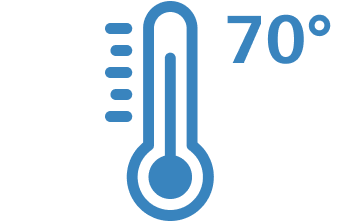Thermal disinfection
To eliminate harmful germs in the pipes, thermal disinfection must be carried out regularly in public buildings. And even in a private household, it is a good way to clean the piping system after your summer holidays abroad.

Remember to first increase the boiler temperature to approx. 70°C in accordance with the legal requirements.
Starting the thermal disinfection
- Set the temperature lever of the tap to hot.
- Place your thumb on the lower part of the sensor.
- The diode lights up and then flashes for a short time.
- Remove your thumb from the sensor as soon as the light of the diode flickers.
- Now the battery status is displayed via light pulses.
- Immediately afterwards, the continuous run for thermal disinfection starts and runs between 3.5 min and 11 min, depending on the set program.
Caution: Risk of scalding!
Ending thermal disinfection early
- To end thermal disinfection prematurely, simply put your thumb back on the lower part of the sensor.
- The diode then gives off a long flash, after which the thumb can be removed from the sensor again and the continuous run is finished.
Alternatively, thermal disinfection can be started by remote control. As with the manual adjustment, the boiler temperature must first be increased and the temperature lever of the tap set to hot.
Thermal disinfection mode by remote control
- First, connect the remote control to the tap.
- Select "Configuration" from the menu and navigate to "Thermal disinfection" using the down arrow key.
- Then the duration of the thermal disinfection can be set between 4 min. and 23 min. via the arrow keys.
- Now the thermal disinfection starts and very hot water flows.
Caution: Risk of scalding!
By selecting "Stop" you can also abort the thermal disinfection prematurely.
Thermal disinfection is mandatory for public buildings in many countries. In principle, thermal disinfection should be carried out by an installer or trained personnel to be on the safe side.

